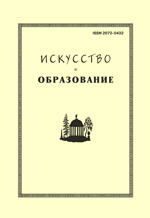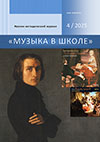
Art and Education

Fine Arts at School

Conference

Music at School

Music and Electronics
Rules and Requirements for submission of scientific and pedagogical research for publication in the online scientific and methodological journal «BULLETIN OF THE INTERNATIONAL CENTRE OF ART AND EDUCATION»
The online scientific and methodological journal «BULLETIN OF THE INTERNATIONAL CENTRE OF ART AND EDUCATION» provides art pedagogy professionals the ability to publish their scientific and methodical work. The editors accept only relevant specialization of the journal materials, such as history and theory of art, art pedagogy, teaching methodology of art education and related areas of knowledge.
The main themes of the journal are:
1.historical development of art as a specific form of human creativity;
2.correlation of art theories and techniques of artistic and esthetic education;
3.art impact on personal development and psychology of art;
4.the art education methodology as a basis for the system of art development in a pedagogically process, self-education, artistic and creative activities;
5.improvement and development of modern methods and art-teaching technologies in extra curricular education, general education and vocational training.
The editors are guided by the principles of science, objectivity, professionalism, informational support to the most important educational and special innovative research, compliance of publishing ethics.
The journal represents two scientific directions: Arts (17.00.00) and pedagogical sciences (13.00.00).
All of articles publishing in the journal are available on the website www.art-in-school.ru. The journal is not responsible for the authenticity of the author’s text in the articles or actual materials and correct citations.
The decision for publishing or rejecting the submitted material is made based on the reviewing regulations. The Journal reserves the right to make changes to the submitted materials, to shorten the text, to reject thematically inappropriate or not properly edited manuscripts, according to the rules of editorial ethics.
Rejected materials can not be reviewed and can not be returned. By sending the article to the editor, the author agrees to publish it in the online scientific and methodological journal «BULLETIN OF THE INTERNATIONAL CENTRE OF ART AND EDUCATION» to place it on the journal's website in the Internet, to transmit the text of the article to third parties (the provision of data is necessary), in order to promote citation and to increase the index of quoting the author and the journal.
The author point of view does not necessarily reflect the position of the editors.
The authors are entirely responsible for the authenticity of the information, quotes, links and bibliography.
Approved permissions to reproduce material of the journal should by issued in writing, otherwise it’s not allowed.
Articles for publication are submitted by e-mail address: kushaev@art-in-school.ru.
Editors necessarily confirm receipt of manuscripts.
In the case of not receiving the notification within seven days, please duplicate the sending of the materials.
The sending material is registered by the editorial staff with an indication of the receipt date, the author / authors name, work place, contacts, the article title.
The editors are ready to cooperate with the authors whose materials contain the results of independent research, if the subject is in the range of the journal’s area of interest. Submissions should not have been published previously in other journals.
The article should be framed with the requirements below and proofread by the author.
1.Technical parameters of the article. The text is typed in Word: font size - 12 Font Headset - Times New Roman, line spacing - 1, margins - 2 cm on all sides. The text length should be up to 15 pages, including abstracts and references (30,000 with spaces), up to 10 pages (20,000 symbols) for postgraduate students, but not less than 15,000 symbols.
2. The structure of the article. The material should contain the following elements: indexes UDC and BBK, the title of the published material, abstract, keywords, text, published material, a list of sources and literature, information about the author / authors; article title, abstract, keywords and author information should be presented in the Russian and English languages.
3.The titles of scientific articles should be informative, concise and represent the essence of the material thematic content. Translated title of the article in English should not be a transliteration from the Russian language, except for proper names, untranslatable names, instruments and other objects that have their own names.
Registration of tables, figures, formulas.
Each table in the text should be referred and named.
Illustrations (photos, drawings, schemes, graphs, diagrams, maps) should be submitted as a separate file in TIF or JPG format with a resolution of at least 300 DPI. Vector formats (AI, EPS) are also possible. The text should contain links to the illustrations that are numbered and accompanied by captions.
The main text of the article may contain notes in the form of automatic footnotes, with continuous numbering. Articles, sent to the Editorial office without compliance with these conditions, will not be accepted.
Regulations on reviewing scientific articles, published in the online scientific and methodological journal «BULLETIN OF THE INTERNATIONAL CENTRE OF ART AND EDUCATION»
For publication in the online scientific and methodological journal «BULLETIN OF THE INTERNATIONAL CENTRE OF ART AND EDUCATION» the editors accept scientific articles containing the main results of research conducted by the author / authors, scientific reviews, the deliverables of scientific events (symposiums, conferences, seminars, and so on), ratings.
If it is necessary, The Editorial Board has the right to involve for reviewing more domestic and foreign experts, the scientific status corresponding to that position.
Издательство: Международный Центр «Искусство и образование» |
Publishing house: International Centre «Art and Education» |
| Вниманию авторов и читателей журнала «Искусство и образование» | ||
Подписаться на журналы можно: |
 |
|
| в Агентстве ООО «Урал-Пресс» | ||
| в Научной электронной библиотеке eLIBRARY.RU | ||
| в ООО «ИВИС» | ||
|
В редакции: Через редакцию можно как подписаться, так и получить отдельные номера журналов в печатном или электронном виде. |
||
| Последнее обновление – 19 декабря 2025 |